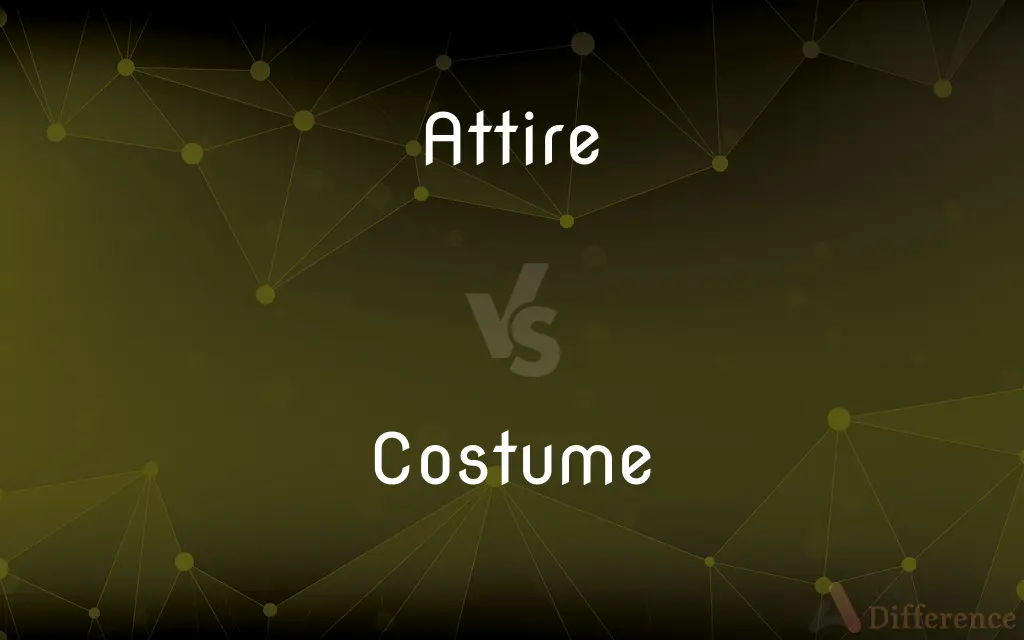Attire vs. Costume — What's the Difference?
Edited by Tayyaba Rehman — By Maham Liaqat — Updated on March 18, 2024
Attire refers to clothing worn daily or for specific occasions, focusing on appropriateness and style, whereas costume is clothing worn to portray a character or theme, often for performances or celebrations.

Difference Between Attire and Costume
Table of Contents
ADVERTISEMENT
Key Differences
Attire encompasses the range of clothing individuals choose to wear in their daily lives or for particular events, emphasizing suitability, fashion, and personal expression. It reflects societal norms and personal preferences, varying from formal wear for business meetings to casual wear for everyday activities. On the other hand, a costume is designed to transform an individual's appearance to represent a specific character, historical period, or thematic idea, primarily used in contexts like theater, Halloween, or theme parties.
While attire can denote a sense of professionalism or adherence to a dress code in work and social settings, costumes aim to entertain, educate, or celebrate by adopting an alternate identity. For example, business attire ensures a professional image in the workplace, whereas a costume might be used by an actor to embody a historical figure in a play.
The selection of attire is often governed by factors like the occasion, cultural standards, and personal style, requiring individuals to navigate social expectations and fashion trends. Conversely, choosing a costume is typically guided by the need to accurately represent a specific theme, character, or era, with less emphasis on personal style and more on authenticity or creativity.
Attire and costumes both play significant roles in cultural and social expressions, but their purposes diverge. Attire supports social conformity and individual identity within everyday contexts, while costumes provide a temporary escape into other roles or fantasy worlds.
The choice between attire and costume can also reflect societal values and transitions, such as seasonal fashion trends in attire versus the celebration of cultural or festive traditions through costumes. This distinction highlights how clothing serves both as a personal and cultural expression.
ADVERTISEMENT
Comparison Chart
Definition
Clothing worn for daily activities or events.
Clothing worn to represent a character or theme.
Purpose
To adhere to social norms and express style.
To portray an identity different from the wearer's.
Occasions
Work, daily life, formal events.
Parties, performances, celebrations.
Selection Criteria
Suitability, fashion, personal expression.
Authenticity, thematic accuracy, creativity.
Social Function
Conformity, professionalism, personal identity.
Entertainment, education, celebration.
Compare with Definitions
Attire
Casual attire refers to comfortable clothes suitable for everyday wear.
She prefers casual attire like jeans and a t-shirt for weekends.
Costume
Historical costumes replicate clothing from a specific period for authenticity.
The actors wore 18th-century costumes for the play.
Attire
Professional attire varies by industry but generally promotes a polished image.
In her office, professional attire is a must.
Costume
Fantasy costumes allow individuals to embody fictional characters.
Her elf costume for the convention was meticulously crafted.
Attire
Attire is the clothing worn for specific occasions or daily life.
His business attire includes a tailored suit and tie.
Costume
A costume is special attire worn to represent a character or theme.
His pirate costume was a hit at the Halloween party.
Attire
Athletic attire is designed for physical activities and sports.
For yoga, she wears flexible and breathable athletic attire.
Costume
Children often wear costumes for imaginative play or events.
For the school play, children wore animal costumes.
Attire
Formal attire is required for certain social events and settings.
The gala dinner required all guests to wear formal attire.
Costume
Costume parties encourage guests to dress up as various characters.
The costume party's theme was superheroes and villains.
Attire
To dress or clothe, especially in fine or elaborate garments.
Costume
Costume is the distinctive style of dress or cosmetic of an individual or group that reflects class, gender, profession, ethnicity, nationality, activity or epoch. In short costume is a cultural visual of the people.
Attire
Clothing or array; apparel.
Costume
A style of dress, including garments, accessories, and hairstyle, especially as characteristic of a particular country, period, or people.
Attire
The antlers of a deer.
Costume
An outfit or a disguise worn on Mardi Gras, Halloween, or similar occasions.
Attire
(clothing) One's dress; what one wears; one's clothes.
He was wearing his formal attire.
Costume
A set of clothes appropriate for a particular occasion or season.
Attire
(heraldry) The single horn of a deer or stag.
Costume
To put a costume on; dress.
Attire
(transitive) To clothe or adorn.
We will attire him in fine clothing so he can make a good impression.
He stood there, attired in his best clothes, waiting for applause.
Costume
To design or furnish costumes for.
Attire
To dress; to array; to adorn; esp., to clothe with elegant or splendid garments.
Finely attired in a robe of white.
With the linen miter shall he be attired.
Costume
A style of dress, including garments, accessories and hairstyle, especially as characteristic of a particular country, period or people.
Attire
Dress; clothes; headdress; anything which dresses or adorns; esp., ornamental clothing.
Earth in her rich attire.
I 'll put myself in poor and mean attire.
Can a maid forget her ornament, or a bride her attire?
Costume
An outfit or a disguise worn as fancy dress etc.
We wore gorilla costumes to the party.
Attire
The antlers, or antlers and scalp, of a stag or buck.
Costume
A set of clothes appropriate for a particular occasion or season.
The bride wore a grey going-away costume.
Attire
The internal parts of a flower, included within the calyx and the corolla.
Costume
To dress or adorn with a costume or appropriate garb.
Attire
Clothing of a distinctive style or for a particular occasion;
Formal attire
Battle dress
Costume
Dress in general; esp., the distinctive style of dress of a people, class, or period.
Attire
Put on special clothes to appear particularly appealing and attractive;
She never dresses up, even when she goes to the opera
The young girls were all fancied up for the party
Costume
Such an arrangement of accessories, as in a picture, statue, poem, or play, as is appropriate to the time, place, or other circumstances represented or described.
I began last night to read Walter Scott's Lay of the Last Minstrel . . . .I was extremely delighted with the poetical beauty of some parts . . . .The costume, too, is admirable.
Costume
A character dress, used at fancy balls or for dramatic purposes.
Costume
The attire worn in a play or at a fancy dress ball;
He won the prize for best costume
Costume
Unusual or period attire not characteristic of or appropriate to the time and place;
In spite of the heat he insisted on his woolen costume
Costume
The prevalent fashion of dress (including accessories and hair style as well as garments)
Costume
The attire characteristic of a country or a time or a social class;
He wore his national costume
Costume
Dress in a costume;
We dressed up for Halloween as pumpkins
Costume
Furnish with costumes; as for a film or play
Common Curiosities
How does attire differ from costume?
Attire is chosen based on social norms, occasion, and personal preference, focusing on daily life or specific events, while costumes are selected to embody a different identity or theme, mainly for entertainment or celebratory purposes.
Can attire be considered a costume?
Attire can be considered a costume if it is worn to depict a character or theme outside of its usual context, such as historical attire worn for a play.
Why is the choice of attire important?
The choice of attire is important as it reflects personal style, complies with social or occupational norms, and is suitable for specific occasions, influencing first impressions and comfort.
What is attire?
Attire refers to the clothes people wear, varying from casual and formal to professional, based on the occasion and personal style.
What makes a good costume?
A good costume accurately represents the intended character or theme, is creative, and attention to detail enhances its authenticity or fun factor.
What is a costume?
A costume is a set of clothes worn to portray a character, theme, or era, often for performances, celebrations, or thematic events.
Can everyday clothing be a costume?
Everyday clothing can become a costume if it is used to purposefully represent a character or theme outside of its normal context.
How do attire choices evolve?
Attire choices evolve with fashion trends, societal changes, and personal growth, reflecting current aesthetics, values, and technological advancements in clothing design.
What is professional attire?
Professional attire is clothing suitable for a workplace environment, which can range from business formal to business casual, depending on the industry standards.
What role does fashion play in attire?
Fashion influences attire by setting trends and standards for what is considered stylish or appropriate in different contexts and times.
What considerations are important for costume design?
Important considerations for costume design include the accuracy, visual impact, comfort, and the ability to convey the intended character or theme effectively.
Are costumes only for Halloween?
Costumes are not only for Halloween; they are also used in theater, school plays, theme parties, and various cultural or celebratory events.
How do cultural differences affect attire?
Cultural differences significantly affect attire choices, reflecting traditional values, norms, and climate considerations in daily wear and formal occasions.
How are costumes used in education?
Costumes can be used in education to bring historical periods, literary characters, or cultural studies to life, making learning more interactive and engaging.
Why do people wear costumes?
People wear costumes to adopt a different identity, celebrate, entertain, participate in events like cosplay, or engage in cultural traditions.
Share Your Discovery

Previous Comparison
Concentration vs. Strength
Next Comparison
Patriarchy vs. FeminismAuthor Spotlight
Written by
Maham LiaqatEdited by
Tayyaba RehmanTayyaba Rehman is a distinguished writer, currently serving as a primary contributor to askdifference.com. As a researcher in semantics and etymology, Tayyaba's passion for the complexity of languages and their distinctions has found a perfect home on the platform. Tayyaba delves into the intricacies of language, distinguishing between commonly confused words and phrases, thereby providing clarity for readers worldwide.
















































